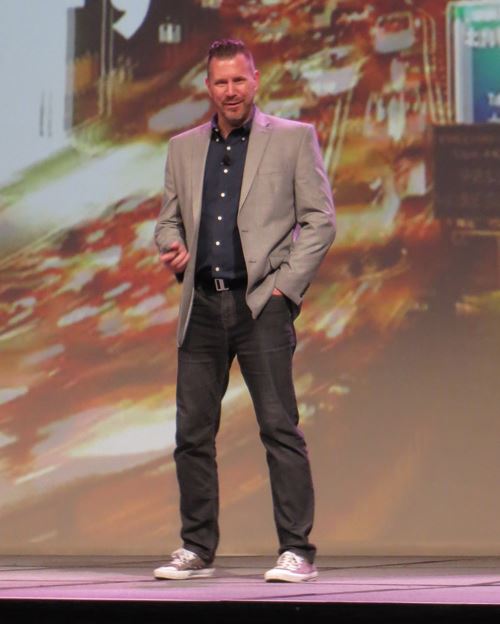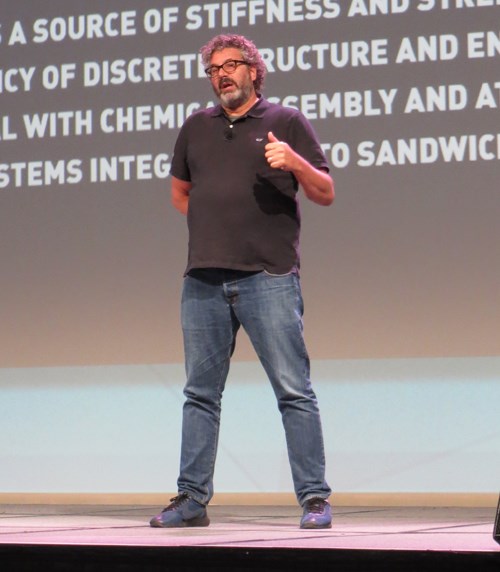Visionaries put composites in perspective
CAMX 2016 keynoters from Luminati Aerospace, Local Motors and Greg Lynn FORM outline their vision for the future of composites.
CAMX 2016 (Sept. 26-29, Anaheim, California) officially kicked off on Sept. 27 with a General Session that featured three creative and visionary keynote speakers who have applied composites in new and compelling ways that promise to change how we think about communication, transportation and architecture. About 1,700 show-goers filled the hall and heard testimony of composite’s high utility as a problem-solving material.
First up was Daniel Preston, CEO and CTO of Luminati Aerospace (Calverton, New York), a new company dedicated to bringing Internet connectivity to all areas of the world. He and his team are developing, among many products and technologies, high-altitude, long-endurance (HALE) unmanned vehicles that will harvest energy from wind and sun to stay aloft. These vehicles will be constructed of carbon fiber composites supplied by Hexcel using automated layup methods.
Due to a scheduling conflict, Preston could not attend CAMX in person, but did appear via video. He commented on his early success as a student (college at age 12, graduated in his teens) and in business (sold his first business and “retired” in his 20s), and how that led, eventually, to the HALE effort, which was prompted by a “large dot-com” seeking to provide Internet access for underserved regions around the world. The result is the V0-Substrata, a solar- and wind-powered, pilot-optional, composite aircraft that, Luminati hopes, will be doing HALE-based work soon.
Next up was Gregory Haye, general manager at Local Motors (Knoxville, Tennessee), who is overseeing his company’s development of vehicles built via advanced, large-format additive manufacturing methods and advanced materials, with a goal of reducing impact on the environment.
Haye walked the session through Local Motors’ “strive for less” mantra, which seeks to rethink how motor vehicle design and development paradigm. Or, as Haye put it, “The vehicle as we know it must die.” Haye emphasized Local Motors’ desire to condense the vehicle development process with digital-based tools that allow fast tooling and manufacturing, with both done via additive manufacturing technology provided by Cincinnati Inc.’s (Cincinnati, Ohio) Big Area Additive Manufacturing (BAAM) machine, which uses a chopped carbon fiber-reinforced ABS. Haye also discussed Local Motors’ work developing in just three months Olli, the multi-passenger, autonomous, composites-intensive mini-bus designed for urban mass-transit.
Wrapping up was Greg Lynn, owner of Greg Lynn FORM (Los Angeles, California), named one of the 10 most in influential architects living today, according to Forbes magazine. Lynn is at the forefront of creating fresh, functional and unusual designs and structures with composite materials.
Like Preston and Haye, Lynn is highly interested in building new paradigms based on the application of composites. In architecture, he noted, composites offer moldability and adaptability not possible with steel and aluminum. As a result, curved weight-bearing structures have become possible, bringing new dynamism to home and building design. The challenge, he said, is that many architects and designers are stuck in paradigm that relies on legacy materials, and they are trying to adapt to fit composites into that mindset. “If you think about composite beams like you think about steel beams, it’s a mistake,” he said, adding, “In fact, if you think about composite beams at all, you’re lost.” Lynn’s work, however, does not stop at building and construction. He’s also experimenting with composites in boat design and manufacture, and he is working with sports teams on innovative composite-based structures designed to help athletes better understand how their body performs in certain conditions, and help them recover from injury more quickly.
Related Content
ASCEND program update: Designing next-gen, high-rate auto and aerospace composites
GKN Aerospace, McLaren Automotive and U.K.-based partners share goals and progress aiming at high-rate, Industry 4.0-enabled, sustainable materials and processes.
Read MorePEEK vs. PEKK vs. PAEK and continuous compression molding
Suppliers of thermoplastics and carbon fiber chime in regarding PEEK vs. PEKK, and now PAEK, as well as in-situ consolidation — the supply chain for thermoplastic tape composites continues to evolve.
Read MoreNext-generation airship design enabled by modern composites
LTA Research’s proof-of-concept Pathfinder 1 modernizes a fully rigid airship design with a largely carbon fiber composite frame. R&D has already begun on higher volume, more automated manufacturing for the future.
Read MoreCryo-compressed hydrogen, the best solution for storage and refueling stations?
Cryomotive’s CRYOGAS solution claims the highest storage density, lowest refueling cost and widest operating range without H2 losses while using one-fifth the carbon fiber required in compressed gas tanks.
Read MoreRead Next
“Structured air” TPS safeguards composite structures
Powered by an 85% air/15% pure polyimide aerogel, Blueshift’s novel material system protects structures during transient thermal events from -200°C to beyond 2400°C for rockets, battery boxes and more.
Read MoreVIDEO: High-volume processing for fiberglass components
Cannon Ergos, a company specializing in high-ton presses and equipment for composites fabrication and plastics processing, displayed automotive and industrial components at CAMX 2024.
Read MoreAll-recycled, needle-punched nonwoven CFRP slashes carbon footprint of Formula 2 seat
Dallara and Tenowo collaborate to produce a race-ready Formula 2 seat using recycled carbon fiber, reducing CO2 emissions by 97.5% compared to virgin materials.
Read More


















.jpg;maxWidth=300;quality=90)









